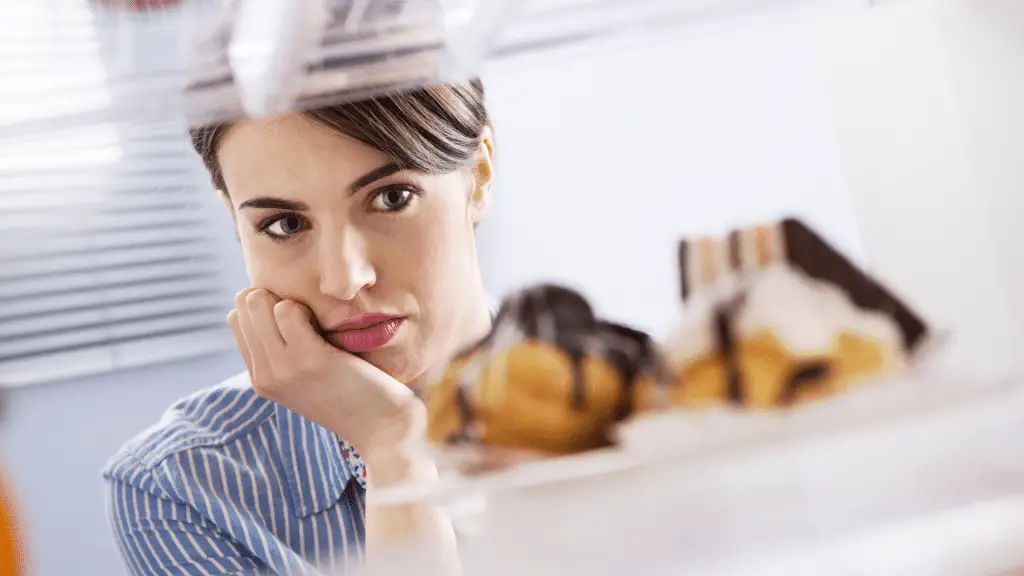I hear you loud and clear: you struggle with food cravings! But what do your food cravings mean? Today, we are not only addressing how to deal with your food cravings but what their meaning might be.
What Do Food Cravings Mean
As you strive to gain victory over your food, it will be helpful to understand what food cravings mean. Sometimes, you will find that your body is just looking for some missing nutrients you can provide by consuming other healthier foods.
Everyone has experienced food cravings. Usually, cravings feel like a strong urge to eat foods high in fat, sugar, and salt.

Food Craving Causes
What causes food cravings? As I mentioned already, sometimes it’s a way for your body to get missing nutrients. Other times, they are caused by your brain’s pleasure center (similar to addictions).
During food craving episodes, craving-specific activation was seen in three regions of the brain: the hippocampus, insula, and caudate. These same three areas have also been reported to be involved in drug craving.
Science News
The Dopamine Effect
On top of activating the pleasure centers in your brain, some foods increase your dopamine levels (a pleasure hormone). Dairy and chocolate are among the most commonly cited foods that boost dopamine levels.
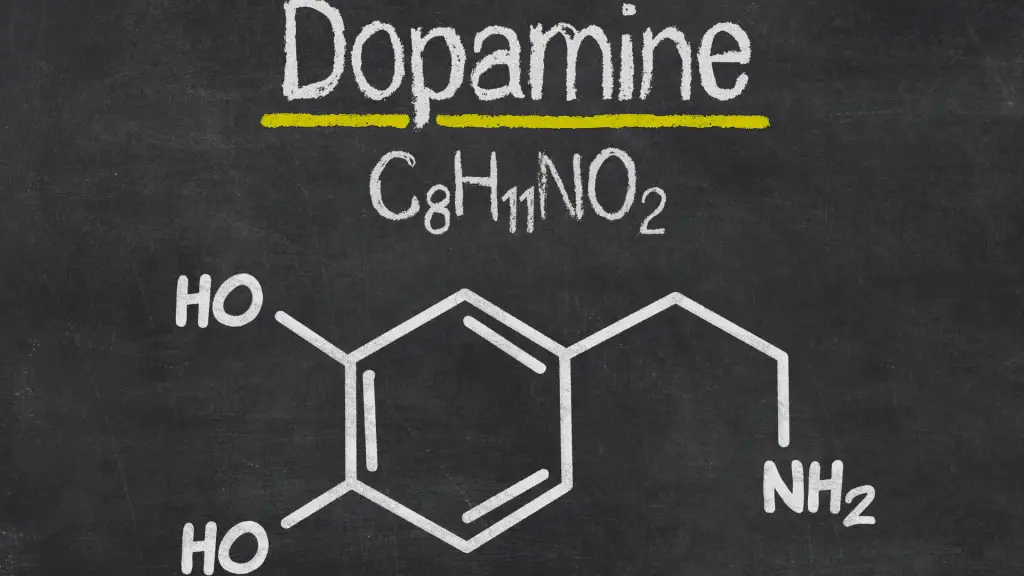
What Do Food Cravings Mean Chart
Retraining your brain will require you to make changes we will address in the next section. For now. let’s address some of the nutritional deficiencies that may be the root of your food cravings.
There are tons of food craving charts online, and I found it frustrating because none of them had legitimate sources or studies to support their claims. I found a chart that included the emotions that people feel when they crave the food in question. I decided to use it as the basis for my own What do food cravings mean chart since we can tell we feel when we crave foods. Hence. the recommendations will be helpful.
I also found another chart that included specific food substitutions. I know that’s what some of my readers are looking for, so I will include this information, too. Just take it with a grain of salt!
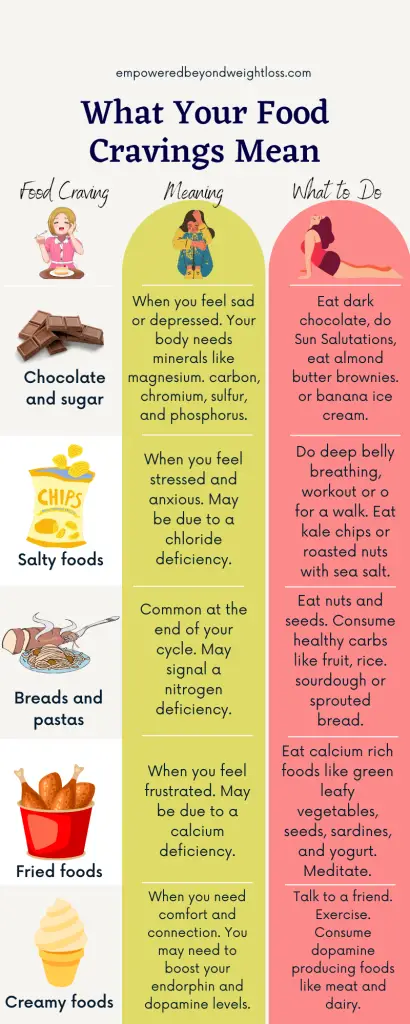
How to Deal With Your Cravings
I have already written a post about how to deal with hunger cravings when fasting (7 Most Effective Ways to Curb Hunger Cravings When Fasting). This post is a bit different. I want to help you deal with cravings when you are not fasting. When you are not fasting, you may feel tempted to binge on foods that don’t serve you well. You may struggle with making food choices that are aligned with your health goals. I am going to help you with that. Keep reading!
6 Tips to Deal With Your Cravings
You will recognize some of the tips here from the what food cravings mean chart. However, instead of giving ways to deal with specific cravings, this section is all about helping you reduce your food cravings long-term by dealing with the most common root causes for food cravings: insulin resistance, psychological associations, and pleasure hormones.
1. Practice Intermittent Fasting
Intermittent fasting helps reduce your food cravings in two significant ways:
- It improves your insulin sensitivity. Cravings are often due to blood sugar ups and downs. When you fast. Your body doesn’t have to produce insulin, which helps improve your insulin sensitivity and stabilizes your blood sugar levels. You will often hear that fasting causes you to overeat later. It’s untrue, particularly for longer fasting windows (20-36 hours).
- It breaks down some of your food associations. Many of your food cravings are caused by lifelong habits you created. You have made associations in your brain that bring you comfort. For example, your mid-afternoon sugary snack makes you feel happy. Not having the option to eat will help you break these habits as you learn new ways to feel satisfied.
To learn more about using intermittent fasting as a tool to reach your health goals, don’t forget to sign up for my Intermittent Fasting 101 Workshop.
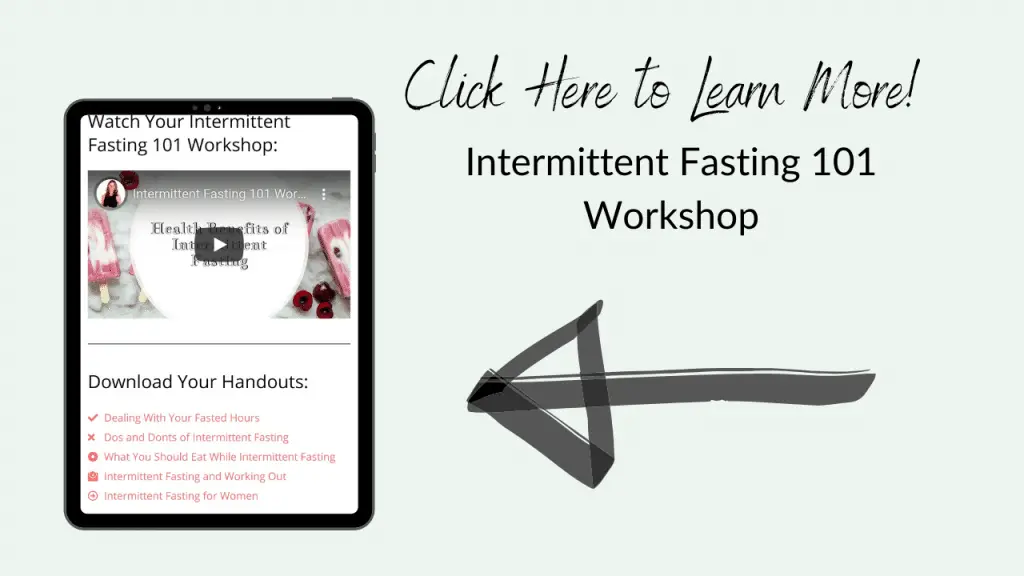
2. Eat Whole Foods
Generally, eating whole foods will help ensure your body benefits from the nutrients it needs to function optimally. Moreover, as you saw on the food craving chart, you can fulfill your cravings with healthier options.
How to Take Advantage of Whole Foods to Beat the Cravings
Let’s recap some of the food substitutions you may want to try when you have food cravings:
- Sugar: Eat dark chocolate or make almond butter cookies or brownies. I enjoy eating almond butter, semi-sweet chocolate chips, and a dash of maple syrup.
- Salty foods: Chips are one of the foods I crave most often. To be honest, I often indulge! Beating your food cravings is not about NEVER allowing yourself to eat the foods you want. It’s about training yourself to make better food choices and discovering your true hunger cues. Eating roasted nuts or kale chips with sea salt when you crave salty foods.
- Bread and pasta: When you crave bread and pasta, you can eat healthier bread and pasta, like gluten-free and sprouted. Also, try sweet potatoes or white potatoes. Enjoy fruit and fruit smoothies.
- Fried foods: If you crave fried foods, eat nuts and seeds. Consume healthy fat-rich foods like avocado and sardines. If you want KFC, an avocado won’t seem very appealing😂 Add some bagel seasonings; trust me, it’s very satisfying! If you like olives, eat some garlic stuffed olives.
- Creamy foods: Cheesecake or ice cream, anyone? Try cashew butter. Consuming more dopamine-producing foods like meat and “clean” dairy may also help.
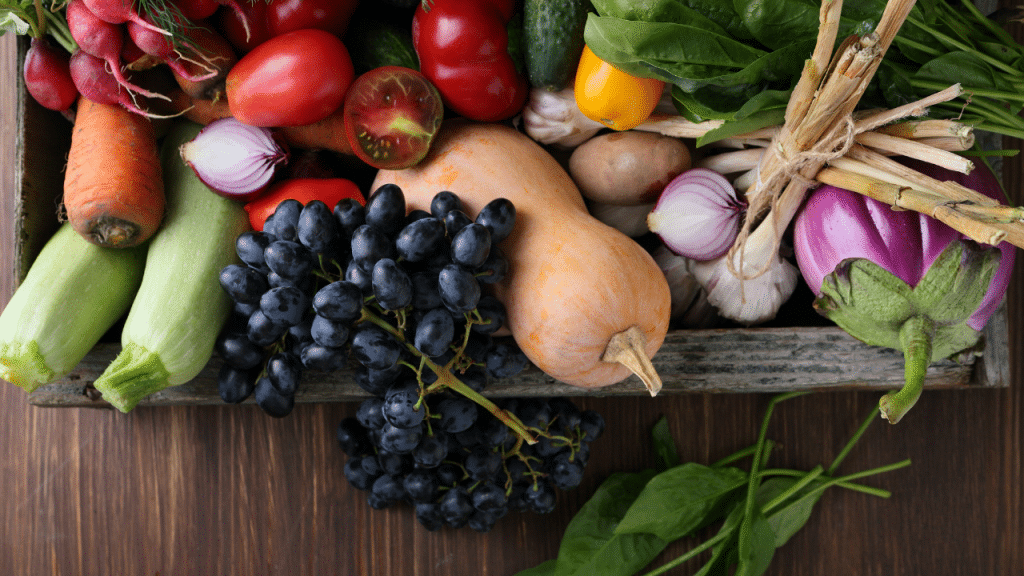
3. Exercise
Exercising is one of the ultimate craving-busting activities. Any time you crave anything, you will notice that a 30-minute walk or workout takes the craving away.
4. Foster Human Connection
We live in a very isolated world. Many of us think we need Netflix more than regular gatherings with other people. However. remember that humans are created to be social. We need to connect with others to function at our best. Make a point of cultivating relationships with others. Look for ways to be helpful. Spend time with friends and family.

5. Meditate
Meditative activities (walking, driving, knitting, deep belly breathing) help calm your body and your mind. These activities increase your dopamine and serotonin levels, which help reduce the need for foods that have the same effect.
6. Spend time In the Sun
Spending 30 minutes a day in the sunlight or bright light will help improve your mood. As you know by now, cravings are often caused by feelings of loneliness and depression. Any activity that boosts your mood and energy will be helpful.
How to Deal With Food Cravings Video


